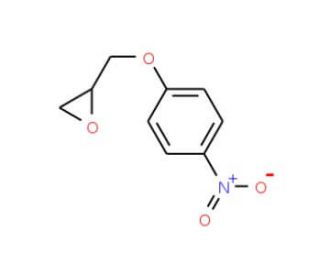

1,2-Epoxy-3-(4-nitrophenoxy)propane (CAS 5255-75-4)
See product citations (2)
QUICK LINKS
1,2-Epoxy-3-(4-nitrophenoxy)propane (ENPP) has garnered attention for its potential applications in the realms of synthetic organic chemistry and materials science. This organic compound, featuring a three-membered cyclic ether ring, serves as a intermediate in the synthesis of diverse organic compounds, spanning polymers, heterocycles, and natural products. Furthermore, its catalytic properties have facilitated the synthesis of polymers and other materials. Additionally, 1,2-Epoxy-3-(4-nitrophenoxy)propane finds utility as a ligand for the synthesis of metal complexes, a reagent in polymer synthesis, and a catalyst for monomer polymerization. Although the precise mechanism of action for 1,2-Epoxy-3-(4-nitrophenoxy)propane remains elusive, it is hypothesized that the reaction involves the nucleophilic attack of p-nitrophenol on propylene oxide. This attack is followed by the formation of an ether linkage between the two components. It is believed that a Lewis acid, such as boron trifluoride, serves as a catalyst for this reaction.
1,2-Epoxy-3-(4-nitrophenoxy)propane (CAS 5255-75-4) References
- Does the detoxification of penicillin side-chain precursors depend on microsomal monooxygenase and glutathione S-transferase in Penicillium chrysogenum? | Emri, T., et al. 2003. J Basic Microbiol. 43: 287-300. PMID: 12872310
- Expression, purification, crystallization and preliminary crystallographic analysis of a stand-alone RAM domain with hydrolytic activity from the hyperthermophile Pyrococcus furiosus. | Agapay, RC., et al. 2005. Acta Crystallogr Sect F Struct Biol Cryst Commun. 61: 914-6. PMID: 16511194
- Purification and biochemical characterization of recombinant simian immunodeficiency virus protease and comparison to human immunodeficiency virus type 1 protease. | Grant, SK., et al. 1991. Biochemistry. 30: 8424-34. PMID: 1883829
- Glutathione conjugation in the isolated perfused rabbit lung: the effects of carbon monoxide, buthionine sulfoximine and cibacron blue. | Yang, CM. and Carlson, GP. 1990. Toxicol Lett. 52: 47-53. PMID: 2356570
- Glutathione-binding site of a bombyx mori theta-class glutathione transferase. | Hossain, MD., et al. 2014. PLoS One. 9: e97740. PMID: 24848539
- Enzymatic characterization of two epsilon-class glutathione S-transferases of Spodoptera litura. | Hirowatari, A., et al. 2018. Arch Insect Biochem Physiol. 97: PMID: 29235695
- Cathepsin D from human leukocytes. Purification by affinity chromatography and properties of the enzyme. | von Clausbruch, UC. and Tschesche, H. 1988. Biol Chem Hoppe Seyler. 369: 683-91. PMID: 3145753
- Conjugation of carcinogens by theta class glutathione s-transferases: mechanisms and relevance to variations in human risk. | Guengerich, FP., et al. 1995. Pharmacogenetics. 5 Spec No: S103-7. PMID: 7581478
- Evidence that human class Theta glutathione S-transferase T1-1 can catalyse the activation of dichloromethane, a liver and lung carcinogen in the mouse. Comparison of the tissue distribution of GST T1-1 with that of classes Alpha, Mu and Pi GST in human. | Sherratt, PJ., et al. 1997. Biochem J. 326 (Pt 3): 837-46. PMID: 9307035
- Kinetic characterization of recombinant human glutathione transferase T1-1, a polymorphic detoxication enzyme. | Jemth, P. and Mannervik, B. 1997. Arch Biochem Biophys. 348: 247-54. PMID: 9434735
- Regulation of rat glutathione S-transferase A5 by cancer chemopreventive agents: mechanisms of inducible resistance to aflatoxin B1. | Hayes, JD., et al. 1998. Chem Biol Interact. 111-112: 51-67. PMID: 9679543
Ordering Information
| Product Name | Catalog # | UNIT | Price | Qty | FAVORITES | |
1,2-Epoxy-3-(4-nitrophenoxy)propane, 250 mg | sc-258906 | 250 mg | $123.00 | |||
1,2-Epoxy-3-(4-nitrophenoxy)propane, 1 g | sc-258906A | 1 g | $291.00 |
